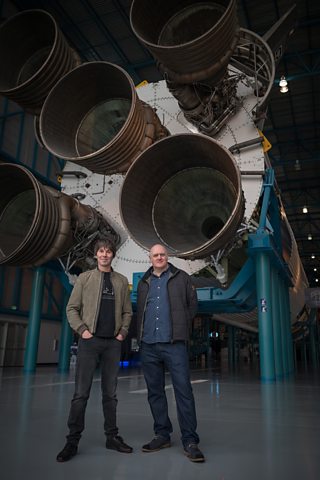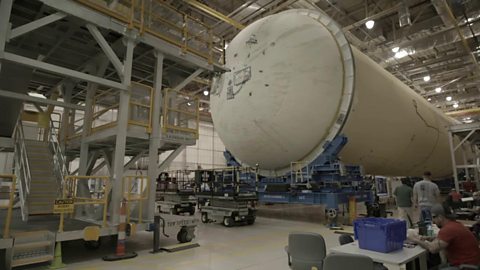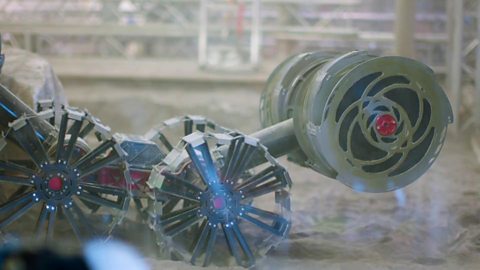Could We Become an Interplanetary Species? What’s next for space travel?
±«Óãtv Two’s Stargazing: Moon Landing Special (15 July) explores the future of space travel. Series Producer Rob Liddell reveals what he’s learnt about the next big step for mankind.

Over the next few years it looks like there will be a revolution in space travel
50 years ago two astronauts, Neil Armstrong and Buzz Aldrin, achieved something that many thought was completely impossible. Their historic journey to the surface of the Moon must be considered one of the greatest engineering achievements of all time. However as the anniversary of this event is celebrated it is clear today the scope of human space travel seems much reduced from what it was in the 1970s.
Right now America, the only nation to have sent astronauts to the surface of another world, has no rockets or spacecraft capable of carrying humans into space at all, let alone into deep space.
But that is about to change.
Over the next few years it looks like there will be a revolution in space travel that will transform how astronauts get into space, where astronauts travel, and even who gets to become an astronaut in the first place.
Getting back to the Moon
On 8th July 2011 Space Shuttle Atlantis blasted off into orbit for the final time, marking the end of NASA’s most successful and complex spacecraft. This incredible vehicle built the International Space Station, or ISS, a laboratory in Low Earth Orbit that has been continuously occupied for 18 years. In total there were 135 Space Shuttle missions, but since its retirement America has had to pay Russia to take its astronauts to space.
In the meantime NASA has been exploring new goals and has set its sights beyond the ISS and into deep space again. The plan is to return humans to the Moon and eventually to Mars.
The goal is as ambitious as it was 50 years ago. And to achieve it NASA is calling for a fundamental change in space travel. The space agency wants to focus its efforts on sending humans to deep space and that means handing over the more ‘routine’ activity of flying to Low Earth Orbit to commercial companies.
Tickets to the International Space Station?
In the next 12 months two companies are hoping the make this a reality. Elon Musk’s SpaceX has developed pioneering self-landing rockets. This makes them reusable and means they have slashed the cost of getting cargo into space. In March 2019 the company achieved a major milestone by successfully testing their Crew Dragon spacecraft. The uncrewed test proved it could dock with the International Space Station.
Hot on Crew Dragon’s heels is Boeing’s Starliner spacecraft. Boeing has been awarded a $4.7 Billion contract from NASA to build the Starliner that will take up to 7 astronauts per flight to the ISS. It’s being built on site at Kennedy Space Center in Florida.

The Spaceship factory
Step inside the Starliner spacecraft factory.
Both companies are commercial enterprises and both plan to sell tickets to private citizens allowing for short stays on the ISS at a cost of 10s of millions of pounds. In doing so they will help make ‘space tourism’ a reality. It is also quite possible commercial companies will be given a role in running the space station itself.
SLS will eventually tower to 111 meters and will be the most powerful rocket ever launched to space
How to get a human into deep space
To aid its deep space missions, NASA is planning a successor to the ISS when its funding runs out – currently expected to be in 2025. It’s exploring creating the Deep Space Gateway, a smaller space station that would orbit near the Moon and could act as a staging post to get down to the lunar surface.
But to reach this new space station NASA needs to build a rocket capable of flying astronauts beyond Earth orbit. A feat that was last achieved by the mighty Saturn V rocket that powered the Apollo programme. So NASA is building the Orion spacecraft and the Space Launch System, or SLS rocket. SLS will eventually tower to 111 meters and will be the most powerful rocket ever launched to space, capable of carrying Orion and its crew of 4 to 24,500 mph, the speed needed to escape Earth's gravity.
Right now the rocket is being built in Michoud, Mississippi and is expected to launch for the first time in 2020.

The World's Most Powerful Rocket
SLS will be the worlds most powerful rocket, here the collosal fuel tanks are being built.
First stop Moon Camp, next stop... Mars?
this new moon programme is aiming to create a lunar base
The goal is to do more than just repeat the feats of Apollo – this new moon programme is aiming to create a lunar base – something the European Space Agency is already committed to. And the Moon will become an important testing ground that could pave the way for future crewed missions to Mars.
As part of this new approach a team at an experimental NASA research facility – Swampworks - has been building robots that could mine the Moon. This isn’t about finding precious metals to return to Earth and make someone very rich. It’s about trying to minimise the amount of cargo need to be blasted into space from our planet. Every kilo costs thousands of pounds in fuel. Instead the idea is the robots could mine the Moon for building materials to create lunar bases. The team is even able to 3D print structures using lunar material.
The most precious resource of any mission is fuel – and even this could be harvested from the Moon. Most rocket fuel is made up of hydrogen and oxygen – two of the most abundant elements in the universe and which bind together to form water – Hâ‚‚0. Whilst at first glance the Moon appears to be an arid desert there is actually water ice in the shade of many of its craters and there’s surface ice near the poles. With 1/6th the gravity of Earth getting this fuel off the Moon is a lot easier and cheaper than carrying it from Earth. So robots could make fuel on the Moon which could be used power rockets back to Earth or on to Mars.

Mining the Moon
Meet the autonomous robots built to mine the Moon.
It all seems very outlandish but so did the idea of having a human stand on the Moon in 1961 when John F Kennedy committed America to the Moon programme. As Robert Mueller, Chief Technologist at NASA’s Swampworks lab says “Everything is there, the only two things missing are technologies and imagination. If we can put those two things together and harness the materials and the energy we have in space, we have all the resources of space we need. We just need to be clever enough to know how to use them.”
It all seems very outlandish but so did the idea of having a human stand on the Moon in 1961
This could be the dawn of a new era of space travel. In the future historians might look back to this moment as the first step of many that lead to humans becoming an interplanetary species, expanding beyond the Earth. Whatever happens the next 10 years look to be an incredibly exciting period.
Watch Stargazing Live: Moon Landing Special on Monday the 15th of July at 9pm
